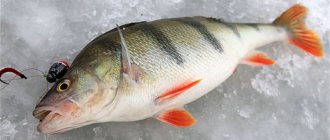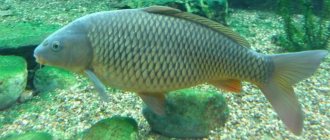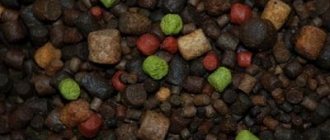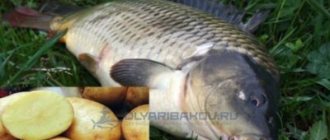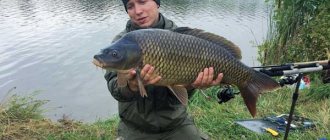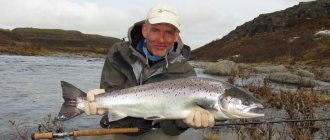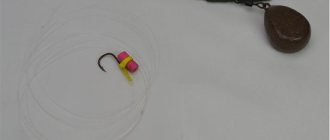This article talks about some of the intricacies of fishing with live worms: the features of the fishing line, the size of the hook and some other tips.
I've been using live worms to catch fish for over two decades now and during that time I've learned a few tricks and tricks that will help anyone live catch more fish with a worm.
If you want to know how to catch fish with a worm, this article is for you. These simple tips and tricks will make you a much more effective fisherman.
Almost all of my worm fishing experience has been in rivers and streams, mainly because I like to fish in running water.
I'm not sure what exactly attracts me. Maybe it's the sound of the water, the scent of nature, or the feel of the water at my feet, but fishing in rivers and streams is my favorite way to fish.
Many of these tips and tricks apply to this type of fishing, although the tips may also apply to other fishing locations and methods.
The most catchable types of worms
There are many species of worms on the planet, but worm fishing for many is simply impossible, and therefore we will describe the following most catchy ones in our area:
- muckworm;
- rain;
- earthen;
- subleaf.
You can also note the Dendroben and Californian worms, but they have a small disadvantage, namely, you cannot find them in the natural environment, but you can only buy them.
Ordinary worms can be found anywhere, they only need moist soil, in addition they are tenacious and attract any fish well.
Dung
Probably the most popular among fishermen is the dung worm. It has one interesting feature, namely, if it is pierced with a hook, a specific yellowish liquid is released, which, spreading in the water, attracts fish well. Worms of this type are usually found in hay or straw stacks near farms.
In the same way, you can find a dung worm under the most ordinary old stump. Typically, worms of this species are small and well suited for catching small fish. They are also suitable for catching large fish, but in this case you need to put not one, but several worms on the hook.
Subleaf
The second line in our ranking is occupied by the subleaf. As the name implies, the habitat of this species is the ground under rotten leaves; they are especially partial to oak leaves. In private homes they can be found under logs or boards that are stored on the ground. This species, like dung ones, cannot boast of large sizes, so they are strung on small hooks or several pieces.
Subleaf
Zemlyanoy
Probably the most common and easily obtained is the earthworm. They can be red or light red, even a little whitish.
This breed of worm is the least attractive of all the ones we describe. They are used when it is not possible to obtain dung or undergrowth. You can find them anywhere, including on the shore of a reservoir where fishing is carried out. Worms of this species are mobile and fish bite well on them, especially in spring.
Rain (crawl)
Earthworms, or simply earthworms, are attractive to fish, as they often appear in their diet in the natural environment. Crawling to the surface during rainstorms, they naturally end up in the reservoir with streams of water. Representatives of these species are probably the largest of those we describe. Excellent for fishing with various gear and for catching large fish on feeders. It is better to fish with a crawler near the bottom. In order to get raincoats, you need to go outside in the dark with a flashlight and walk along dirt paths. You need to be quick because, sensing danger, they hide in their holes.
Worm as bait
A distinctive feature of the worm is that any fish can be caught with it. When the worm is on the hook, you don't know exactly who is taking the bait and making the bobber dance. It could be a goby and a gudgeon, and probably a perch or pike perch, also cyprinids - crucian carp, carp, bream, roach or even catfish... Even spinning anglers use plastic imitations of worms, which they successfully use to catch pike and other predators.
All large fish are excellently caught on crawls. For small fish, the most preferred type of worm remains the small red dung worm, which has a pungent odor and greater mobility on the hook.
How to store
When fishing, it is very important to keep your worms in good health. To do this, it is necessary to provide the necessary environment for their temporary life in a fishing box - in a container with soil from the place where they were mined.
Worms cannot tolerate overheating; if they are in a closed container under the hot sun, they quickly die. They should only be stored in a shaded place. Sometimes it is useful to wrap the container in a wet towel to cool it down. They must definitely maintain their mobility, because this quality of worms is an important attractant for fish.
Baiting a hook
The method of baiting the hook should also provide the worm with maximum freedom of movement.
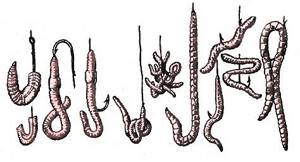
To securely hold one worm on the hook, it is enough to pierce it in one place, sometimes in two places, while it will be able to maintain its mobility, which is tempting for the fish.
The number of punctures also depends on the distance. To increase reliability over long distances, you can increase the number of punctures, or use a complete closure of the hook with a worm.
Use of hooks with reverse barbs
There are hooks specifically designed for worm fishing. They have reverse barbs on the forend that prevent them from slipping back. But the use of such hooks is not a prerequisite for successful fishing, but only prevents the active fish from tearing off the worm.
If the fish is cautious, then it is better not to use barbed hooks.
Features of the modern approach to worm fishing
When baiting, it is better to leave the hook tip free. This is how athletes catch fish using sensitive equipment. At the same time, the efficiency of hooking increases significantly, or the fish self-hatching occurs. But the hooks used must correspond to modern ideas about sharpness. A good hook is known to stick to the nail.
Which hooks to choose for a worm
- For crawling, large hooks No. 3 – 6 are suitable for large fish. Hooks with barbs are more suitable here.
- For baiting dung worms, it is good to use size No. 10-14; these small hooks can be selected without reverse barbs.
- If you are going to catch small worms with a large bunch (usually bream prefers this), then you will need a slightly larger hook.
How many worms to bait?
Whether to attach several worms, one worm, or only part of it to the hook depends mainly on the biting activity and the type of intended prey.
- If the fish bites well, then it is more effective to bait only a piece of the worm. Its attractiveness will be sufficient for active fish, and at the same time the number of idle hooks will be less, since the hook will almost always end up in the fish’s mouth.
- If you are aiming for a trophy, then it is better to use a large bait that would cut off the small things. When small things are in the bycatch and are not very disturbing, then you should not worry that a large fish will bypass a small bait, this usually does not happen.
- To create more scent and attract fish at night, as well as in murky water, it is effective to put many pieces on the hook at the same time. A cut worm is most suitable for night fishing.
Fishing Features
Do not forget that when hooked in water, the worm gradually loses its mobility and smell. Therefore, if there is no bite, it must be replaced periodically, at least every 30 minutes, with a fresh one. Typically, experienced fishermen recommend baiting the worm so that the sting looks out. This increases catchability if the rig is informative enough and the angler reacts as soon as the hook is in the mouth. But amateur fishing has its own approach to this issue. If the fish pulled the worm a little, then it needs to be adjusted to close the hook completely. The best option out of these can only be determined independently, based on the reservoir, the mood of the fish, and the available gear….
Storing and preparing worms
For fishing to be successful, simply digging up worms is not enough. As we have already said, worms differ in species as a result of this and their attractiveness to fish varies.
While on a pond, you can often see the following picture, when one fisherman drags fish one after another, and everyone else doesn’t even get a bite. Sometimes this can be explained by a good choice of location, but more often the whole secret is that his worms are properly prepared.
Much in this matter depends on the conditions in which the worms were stored. We will not consider methods that allow you to store worms for a long time, but we will tell you how to store them on the eve of fishing. The best place in which worms are best preserved is the most common basement. To do this, you need to take a plastic or wooden box, pour soil into it (preferably from the place where the worms were mined) and feed it periodically. When making a soil mixture, it is advisable to mix the soil with rotted leaves and sand. Storage boxes must have holes drilled for ventilation.

Storage box
You can feed him cottage cheese (preferably low-fat). Grated potatoes or tea leaves are also suitable.
If you are going to catch carp or catfish, then you need to pour a few tablespoons of vegetable oil into the soil in which the worms are stored. This will make the bait more attractive
During storage, many worms die and there is one good and simple way to filter dead individuals from living ones. To do this, take a “chain-link”, pour soil onto it, and place some container underneath. Living specimens, crawling out, will begin to fall down, and dead ones will remain in the ground; they must be thrown away, as fish will not bite on a dead worm.
If you don’t plan to store the worms for a long time, then you can simply put them in a jar and sprinkle leaves, grass or moss on top. If you notice that the worms are inactive, then of course you can’t count on good fishing, so they need to be prepared in a special way. To do this, rotted manure is added to the ground in which the worms are stored. Then you need to add rotted sawdust or straw to this soil. Humidity should be minimal. The worms should remain in this soil mixture for at least a day. If they stay in it longer, they need additional feeding.
How to bait or replace a worm correctly
Baiting and replacing a worm seems simple at first glance, but there are some tricks and techniques.
The most common method is to pierce the worm from the head and then pull it on like a stocking.
You can also pierce it in the middle, while the tails curl freely.
Sometimes you can try to fish not with a whole worm, but tear off a small part or half from it and pull it onto the tip of the hook.
If the worms are small, then try to attach several of them at once, puncturing one in the middle or one across and the other along so that the hook closes.
When catching large fish, the following method is often used. Several worms need to be pierced near the head, a few more approximately in the middle, and a couple more near the tail. The result is a moving tuft that is extremely attractive to large fish of various breeds. This option is also suitable if you are fishing with small worms, for example, underleaves.

Worms planted in a bunch
It is better to prick large raincoats with an accordion.
One of the advantages of a worm as a bait is that it can be put on a hook with other baits. This is not done in order to put, for example, several different baits on a hook, hoping that the fish will bite on one of them. Very often, fish are attracted directly to the entire “sandwich” itself. If you fish with float tackle, then try this option. A couple of worms and a few maggots. Or one worm and 3-4 bloodworms.
When using feeder fishing, a good option is a few maggots - a worm - a few bloodworms. It is also advisable to string a foam ball. Taking into account the fairly significant overall weight of the bait, the foam will not lift the “sandwich” above the bottom, and will prevent the bait from sinking quickly. The fish likes it when the bait descends slowly and often attacks it at this time.
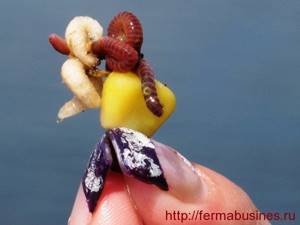
Sandwich
Combinations with bait of plant origin, for example, corn, peas or pearl barley, are acceptable.
Although the worm is a fairly strong bait, it needs to be given a little more attention than the same maggot.
Often, many fishermen have the same question, namely, how often should the worm be changed? In this case, we do not recommend rushing. And if the fish bites well on the chewed worm, there is no need to change it, but continue fishing until the fish has completely eaten it. It is also not uncommon for a fish, especially a large one, such as bream, to bite better on a dead worm. It is also not uncommon for a fish to refuse to take the bait while it is moving. In such a situation, you can try planting several worms at once, alternating dead and fresh ones.
But frequent replacement is also possible in some situations; here, a lot depends on the conditions and fishing location.
You can fish with hooks of various sizes. The main condition is that the length of the forend is sufficient to plant the required number of worms.
The question is controversial whether it is necessary to bring the tip of the hook out, or whether this should not be done.
Many anglers recommend leaving the tip open when fishing in rivers, and closing it when fishing in bets or lakes. If you fish with a “sandwich”, then it is advisable to open the tip.
Feeding with worms
Many people probably don’t know, but worms can be used not only as bait, but also as feeding.
Especially if you plan to fish for them. The worms are ideally compatible with any nutritional mixtures; as a result, they cannot spoil the feeding. And even the opposite, since cut worms perfectly complement the bait. In addition, a predator, for example, a perch, can also come for such complementary feeding.
Preparing a worm for bait is not difficult. You just need to cut them and mix them with a nutrient substance.
If you want to add a few worms (for example, to experiment in case of complete lack of bite), you should not mix them with the whole bait.
When using feeder fishing, you can put a couple of pieces into a filled feeder and see how the fish will react to this option. If it’s good, then you can continue feeding according to the same scheme.
If the fishing is successful, you need to act the same way.

Top dressing
Worms are not often fed, probably because it is more difficult to obtain than corn or the most common food, pearl barley. But they often experiment in this direction.
Experienced fishermen prefer to make the so-called “worm pie”. It is not difficult to make and is practiced when fishing from a boat. To do this, a piece of coastal turf is cut out and stuffed with worms and maggots. Next, this “pie” is taken to the fishing site and carefully immersed in the water. Worms and maggots gradually emerge from this piece and attract fish.
To summarize, we can say that it is advisable to experiment with worms more often; this is the best bait for most types of fish! Good luck!
Secrets of fishing with a worm
There are not so many secrets in fishing with a worm. The bait is popular, tasty, and interesting for any fish. Attracts fish both with its specific smell and movement in the water.
- If you dip a worm in sunflower or hemp oil , a cloud that is attractive to fish will form around it. This is also true for garlic juice. In this case, the pungent juice of the garlic causes the worm to squirm, attracting even more fish. Many anglers use other attractants when fishing with worms.
- You need to fish with a worm at the very bottom. It’s easier for fish to find it there. In the middle and upper layers of water, fish react only to a moving worm. For example, if a fish is basking near the surface, it is enough to make a short step-by-step retrieve with a worm at a depth of about 10 cm to attract the attention of the fish. In the middle layers of water, it is good to fish with a worm in a current (weak or strong).
- Sometimes the nozzle lying on the bottom needs to be pulled up. For a worm, this action always works.
Unfortunately, this attachment does not last forever and needs to be changed periodically. There is nothing difficult in fishing using a worm; even a beginner can cope with such bait.

